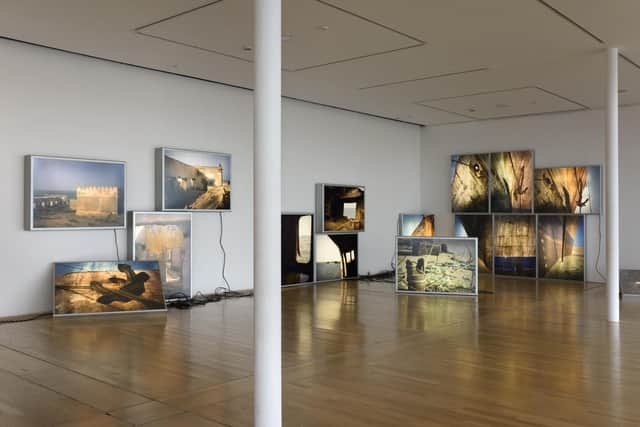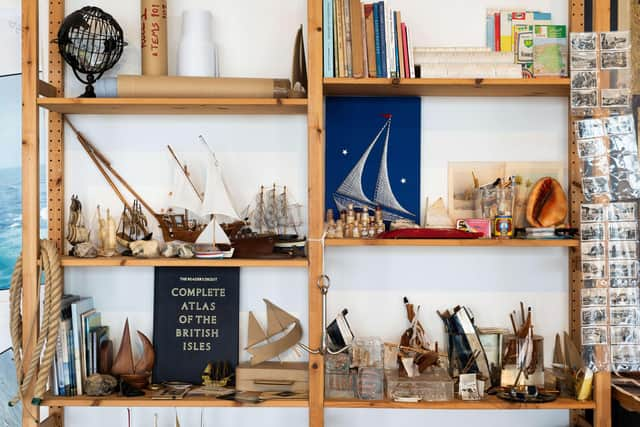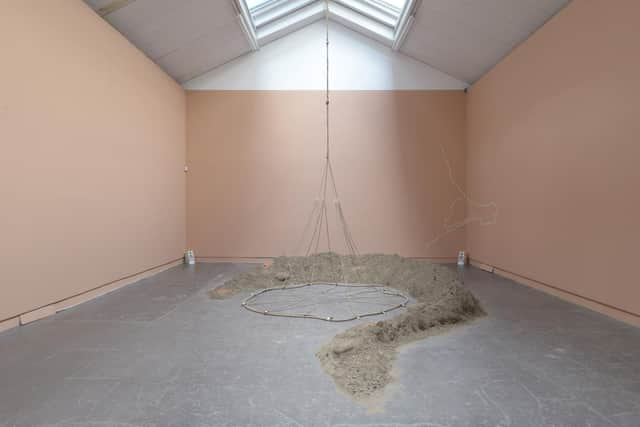Art reviews: Zineb Sedira | All Islands Connect Under Water
Zineb Sedira: Can’t You See the Sea Changing?, Dundee Contemporary Arts ****
All Islands Connect Under Water, CCA, Glasgow ***
The sea is everywhere in Zineb Sedira’s new show, developed collaboratively between Dundee Contemporary Arts and the De La Warr Pavilion, Bexhill on Sea. You can almost hear the waves, smell the brine. You think if you could look out of one of DCA’s long, high windows, you might see the ocean crashing below.


Advertisement
Hide AdSedira, who is French-Algerian, represented France at last year’s Venice Biennale, creating one of the most talked about shows of the festival in which she wove her own history into a collage of Algerian-made films, and turned the rooms of the pavilion into stage sets; one was a meticulous copy of part of her London flat.
She employs the same approach here, recreating part of her studio – further evidence, if it is needed, of her fascination with the sea. There are model boats, maps, nautical books, old black and white postcards of ports and fishermen, a lamp shaped like a conch shell. It’s a valuable extra layer, but perhaps not strictly necessary: evidence of her fascination is all around us.
The work, made over the last 15 years, includes the previously unseen series Sea Rocks, five large-scale, high-definition photographs of rock formations at Cap Sigli, Algeria, where the rocks are eroded into cavities, swirls and delicate-seeming lattice structures. On free-standing wooden mounts, they evoke sculptures or stage scenery.
Another photographic series, Shattered Carcasses and Architecture of the Forsaken, depicts the rusting hulks of abandoned ships at Nouadhibou on the coast of Mauritania. On light boxes arranged on the walls and floor, they place us in the midst of the drama of the place, as if we are looking into and through these vessels, or into the ruined concrete buildings on the shore, while the rusting bow of a ship towers above us.


The other works in the show explore sea fever on a more human scale. A film installation introduces us to the work of Marcel Baudelaire, an amateur photographer who recorded, thoroughly and meticulously, ships of all kinds arriving at Marseilles harbour from the 1930s to the 1980s. His collection of more than 2,000 prints, slides and plate-glass negatives is now in a museum, but the man himself, who died in the 1990s – real name Yvon Colas – remains largely a mystery.
Lighthouse in the Sea of Time, made for the Folkestone Triennial in 2011, is perhaps the stand-out work here, an in-depth film portrait of two Algerian lighthouses, Cap Sigli and Cap Caxine. A four-channel film installation does with moving image what Sedira has done with the Nouadhibou photographs, creating a three-dimensional picture of lighthouse life, from the waves crashing below to the clanking and whirring of the light itself. The picture is then expanded by an interview with the keeper of the Cap Sigli light, a man with a face straight out of a Velasquez painting who speaks with passionate detail about his lighthouse and his love for it.
Advertisement
Hide AdSedira simply shows us all of this, framing each shot with care, as she does in her photographs, always attentive to composition, atmosphere, the fall of light. She offers the specifics, and the resonances take care of themselves: the symbolism of a lighthouse and its role, not only in keeping seafarers safe but in protecting mercantile cargo and marking territory (both these lighthouses were built during the French occupation of Algeria).
The sea, then, is a conduit for merchants and colonisers, an expanse which keeps the exile from home, or carries the refugee to safety (albeit by perilous means). It is both dangerous and vulnerable, an ecosystem at the frontline of climate change (surely this must be part of the “change” of the title?), open to use and abuse: think of the Western nations which dispose of obsolete ships far from home, in places like Mauritania.


Advertisement
Hide AdLinger awhile and these waves start to lap over you, but the decision is yours whether your imagination takes you on an adventure on the high seas or a quest for ecological justice, or something else altogether. There is something in the quality and presence of the work which make all these options possible.
The approach is very different in All Islands Connect Under Water, although the territory under consideration is actually very similar. This exhibition is the conclusion of Confluence, a year’s residency and research programme between CCA in Glasgow and QANAT in Marrakech, and the show, featuring the work of three artists, is curated by Alaya Ang (Glasgow) and Francesca Masoero and Shayman Nadar (Morocco). Here, too, the sea is central, as a repository of memory and history, a liminal space or “barzakh”, a place of contested territory and ecological vulnerability.
Islam Shabana’s work addresses the twin threats of flood and drought. While cities on the Mediterranean face the prospect of rising waters, the inland cities of North Africa face opposite problem: desertification. In The Wet Knowledge of the Prophet Daniel, clips of flooding in Alexandria are interspersed with portentous quotations from the Old Testament prophet, while his second film A Paradise, in Walls of Nothingness shows the dessication of a palm grove near Marrakech, as well as the now-empty underground caverns of a traditional water system.
Asha Athman’s installation, Sowing & Mending, evokes the issues facing coastal communities in Somalia, threatened by unregulated foreign fishing which damages both local livelihoods and the ecosystem. While her installation of sand, a handmade net of rope, a wall drawing and soundtrack, evoke a sense of place, the work needs a supporting text to explain the specifics.


Samra Mayanja’s work is another film, Blueprint for the Deep, which compresses into 12 minutes an overabundance of inspiration and raw material: Paul Robeson’s Song of Freedom, lines by Ugandan playwright Elvania Namukwaya Zirimu, an interview with black climate activist Vanessa Nakate, whose image was cropped out of a group photo from the UN Climate Summit, and the story of Nigerian Harrison Okene, who survived under water for three days after a shipwreck by breathing a pocket of trapped air.
Audio and visual information is layered and distorted in order to (we’re told) “bring out the psycho-affective effects of the ongoing histories of incompleteness and emotional afterlife of exclusion”. But, the viewer is left with a sense of overstimulated confusion.
Advertisement
Hide AdThe contrast with the clarity, stillness and attention of Sedira’s work is marked. Perhaps the difference is in part generational. The “more is more” aesthetic – layering information and ideas, sound and images to the point of saturation – is one which seems to be employed increasingly by the emerging cohort of “multidisciplinary artists”. Perhaps it speaks to a generation for whom media saturation is the norm, but the danger is that it closes down the baffled imagination rather than holding the space open for thought and response.
Zineb Sedira: Can’t You See the Sea Changing? until 6 August; All Islands Connect Under Water until 3 June.